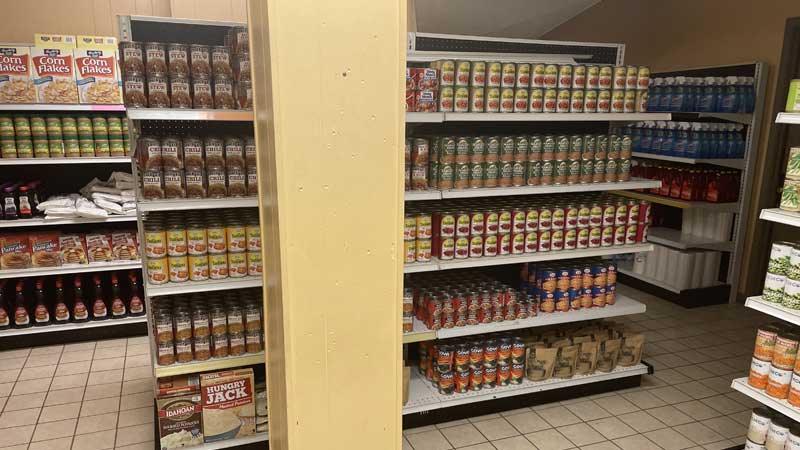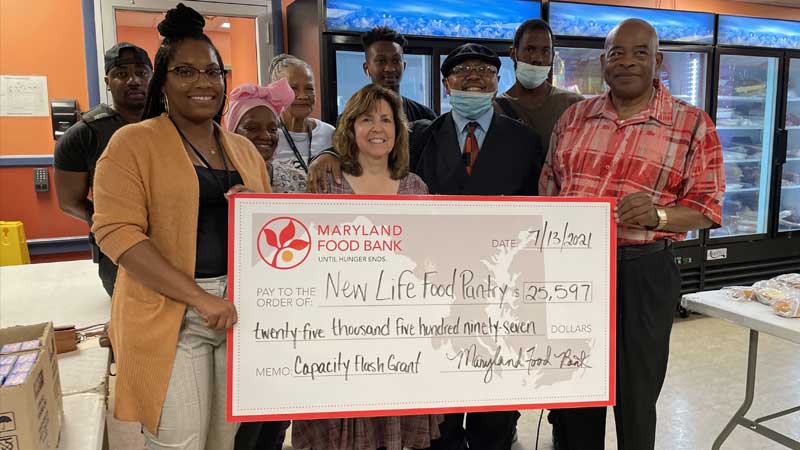Funding a Brighter Future for All Marylanders

Over the last year and a half, the Maryland Food Bank’s Network Partners—“boots-on-the-ground” food pantries, shelters, and community organizations throughout Maryland—scrambled to find innovative ways to keep so many of our neighbors from going hungry during a time of never before seen need for food assistance.
Their ability to respond to this surge in demand, however, would not have been possible without the more than $33.6 million in public and private funding that MFB began redistributing across our statewide food assistance network almost immediately last spring and continues to allocate today.
“The food bank pivoted quickly to provide as much direct support as possible to our Network Partners because they make up the foundation of Maryland’s food assistance safety net,” said MFB’s Senior Vice President of Programs Nekeisia Booyer. “Simply put, without these local organizations, many hungry Marylanders would have nowhere to turn.”
“These are resilient, dedicated organizations that know their neighborhoods, and understand the resources that are needed to uplift residents and create healthy, vibrant communities.”
Despite the fears and anxieties associated with the spread of COVID, nearly 80% of MFB’s 350+ Network Partners remained operational in 2020, collaborating with the food bank to distribute more food than ever before. Regina Brantley, the food pantry director at LIFE Church Ministries in south Baltimore, told us that partnering with MFB made all the difference this past year.
“I’m so glad the food bank is open,” Brantley said last spring. “That’s what helped make things less scary for me… that if the food bank was still willing to share food that we could then share with the public, then things were okay. It gave me some ease.”
Transformative Need Requires Transformative Support
With the sudden emergence of COVID-19 last March, we realized early on that the most effective way to help the influx of Marylanders who suddenly found themselves struggling to feed their families was to purchase and provide food directly to our network.
“Since last spring, more than $32 million has been used to purchase food, much of it from state and local jurisdictions that were confident in our ability to work quickly to keep pace with a near doubling of demand statewide,” explained Meg Kimmel, Executive Vice President & Chief Strategy Officer at MFB. “Once those dollars were turned into food, our network of community partners made sure to connect that food with the Marylanders who needed it most.”

“Every time we were about to run out of food, more food became available from the food bank.”
In addition to making zero cost food available to partners, MFB provided over $620,000 in grants in the fall so that pantries and soup kitchens could better handle, store, and distribute the influx of food necessary to meet the high demand. With these funds, they could order an assortment of equipment and supplies that allowed for more efficient food distribution, including gift cards, PPE, handcarts, coolers, grocery bags, and more.
“We ordered two heavy duty carts to move food, especially when our food distribution moved outside,” said Wanda Singleton from Mt. Hope Ministry in Hagerstown, Md. “The wheels on the old grocery carts we had been using were getting busted up taking food up the alley, but these new carts work great, and they save our backs. Perfect timing and a big blessing.”
Funds for Food, Freezers and More
Most recently, MFB awarded more than $776,000 in Capacity Building Grants to 57 Network Partners this summer to support existing programs and broaden solutions to meet the increased need in their communities, even as the pandemic seemingly recedes.
“Many Network Partners are still seeing high attendance at their distribution events, a sustained need that we believe will continue since so many Marylanders are still struggling to get back on their feet.”
“What sets our grantmaking program apart is that we take a more personal approach, rather than the transactional process you might see with other nonprofits,” Booyer explained. “We rely on our Regional Program Directors’ (RPDs) intimate knowledge of the partners in their areas. They recognize each of their partners’ capacity limits and understand what is needed to help these partners do their best work to effectively feed their local communities.”
Together, the grantmaking team worked with the RPDs to ensure funds were distributed equitably across Maryland, awarding amounts that ranged from $2,000 to $52,000 for a variety of specific needs and special projects.

Most requests focused on expanding partners’ capacity to house and distribute fresh and shelf-stable foods, while many were interested in improving the client experience through enhanced physical spaces. Still others prioritized vehicles, food safety, technology, marketing, operational efficiency, and program expansion.
“During these unprecedented times there is absolutely no way we could still be serving our community and fighting hunger without this partnership,” said Eileen Compton-Little, executive director of the Community Crisis Center in Reisterstown, Md. “The funds, support, and programs provided by the MFB have played an essential role in our local fight against COVID-induced food insecurity.”
“We are so grateful for all the food bank does to help us help others.”
Network Partners Are Essential
All told, these critical resources have made the difference for many food distribution programs that would otherwise have been forced to close their doors over the last year, leaving Marylanders with few places to turn for food.
But we know that ongoing collaboration with Network Partners will be essential to our ability to not only meet the continued increased need, but to address the root causes of hunger that lead individuals to these sites in the first place.

“We see this continued grantmaking program as an extension of the real work that’s needed if we’re going to truly help Marylanders recover from this once-in-a-lifetime crisis,” Booyer explained. “Our Network Partners are key to helping us expand food access while providing resources beyond food, so that food-insecure Marylanders can build financial stability and find pathways out of hunger.”
With this in mind, the food bank will continue to be a grant-providing organization, using a more community-centered approach that will involve direct interaction and ongoing conversations with Network Partners.
Discussions are already underway around two new MFB grants that will provide future opportunities for support: Seed Funding Grants, which are designed to launch new partnerships and fund expansion into high-need areas lacking an MFB Network Partner; and Innovation Grants, which will encourage Network Partners to develop new, creative ideas to distribute food and form partnerships that help address root causes of hunger.
“We’re making a transformational shift in how the food bank operates, and it’s essential that our Network Partners make this journey with us. But we can’t expect them to do this work on their own — we know they will need additional support,” Kimmel added. “By providing even more resources through our grantmaking program, we hope to significantly extend the reach of Maryland’s food assistance safety net for years to come.”
We Need Your Help
Programs, campaigns, and educational outreach at the Maryland Food Bank has always relied on the philanthropic support of charitable individuals like you.
Much like our food distribution efforts, outreach activities at the Maryland Food Bank rely on generous donations of money and time.
We hope you’ll consider a contribution.







